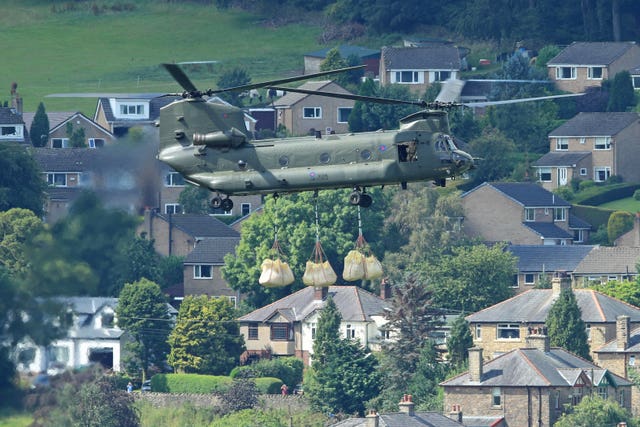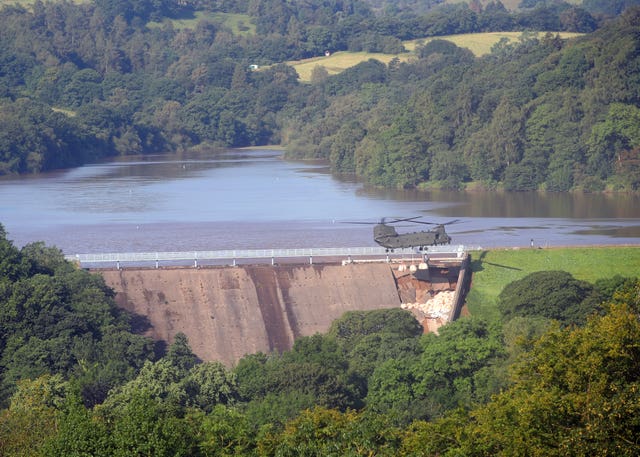
Residents of a town evacuated due to fears a nearby reservoir could collapse will be temporarily allowed home to collect essentials as the damaged dam remains at a “critical level”.
Water levels at the Toddbrook Reservoir have been reduced by half a metre but engineers remain “very concerned” about the integrity of the damaged 180-year-old structure, which contains around 1.3 million tonnes of water.
Hundreds of people have been evacuated from the Derbyshire town of Whaley Bridge over fears it could rupture and flood their homes.
Prime Minister Boris Johnson is visiting Whaley Bridge amid the concerns over the dam.
An RAF Chinook and around 150 firefighters using high-volume pumps appear to have partly stabilised the “unprecedented, fast-moving emergency situation” caused by heavy rain.
During a multi-agency press conference, Assistant Chief Constable Kem Mehmet of Derbyshire Police said there was still “a substantial threat to life” if the dam wall fails.
“We would ask residents to continue to heed police advice and stay away from Whaley Bridge,” he told the press conference on Friday.
Due to concerns raised by residents over pets being left behind, he said officers had made the “difficult” decision to allow people to return to their homes temporarily.
“We will be putting plans in place for residents to return to their home to pick up very vital things they need along with their animal welfare,” he told reporters.
“This is very controlled, I must stress that, because this is still life at risk.”

Numbers returning will be restricted to one person per household, he said, and it was “difficult” to say when people would be allowed to return permanently.
Julie Sharman, chief operating officer for the Canal and River Trust, told the press conference the water level needs to be reduced by “several more” metres, with more pumps being installed on Friday evening.
“This is still a very critical situation,” she said.
“Until we are confident we can control that risk, then our position has to be to protect the public safety and limit access because we don’t want to put people at risk.”
The Chinook has been dropping one-ton sandbags on to the damaged area to bolster the structure.
Improving weather and work on the inflows means the amount of water entering the reservoir has also reduced.

Police have closed railway lines in the Whaley Bridge area over the risk of potential flooding.
The Prime Minister said “first responders, engineers and RAF crews are working around the clock to fix the dam” and he has ordered Environment Secretary Theresa Villiers to chair a meeting of the Cobra emergency committee to discuss the situation.
Around 1,000 people were evacuated from the town but most found their own accommodation with family and friends, according to Derbyshire County Council.

Carolyn Whittle, who lives in Meadowfield on the hillside in Whaley Bridge, said: “I’ve lived in Whaley for the best part of 45 years and I’ve never seen water flood over the dam like that, ever, nor thought that we could possibly be at risk in this way.”
The Environment Agency issued a “danger to life” warning covering the River Goyt on Thursday, as the river could “rise rapidly” due to water rushing in from the reservoir.
Meanwhile, clean-up operations are under way across parts of the North West hit by heavy rain, including Poynton in Cheshire – where residents were evacuated on Wednesday night.
The Environment Agency has 10 flood alerts, six flood warnings and one severe flood warning in place across England.

Richard Parry, chief executive of the Canal and River Trust, said an annual inspection of the Toddbrook Reservoir by a senior engineer took place last November.
The reservoir is on the north-west edge of the Peak District National Park and was built in 1831, according to experts, although the Environment Agency records it as being built in 1840-41.
According to a 2011 Environment Agency report on national dam incidents, Toddbrook “has a history of leakage”.


Why are you making commenting on The National only available to subscribers?
We know there are thousands of National readers who want to debate, argue and go back and forth in the comments section of our stories. We’ve got the most informed readers in Scotland, asking each other the big questions about the future of our country.
Unfortunately, though, these important debates are being spoiled by a vocal minority of trolls who aren’t really interested in the issues, try to derail the conversations, register under fake names, and post vile abuse.
So that’s why we’ve decided to make the ability to comment only available to our paying subscribers. That way, all the trolls who post abuse on our website will have to pay if they want to join the debate – and risk a permanent ban from the account that they subscribe with.
The conversation will go back to what it should be about – people who care passionately about the issues, but disagree constructively on what we should do about them. Let’s get that debate started!
Callum Baird, Editor of The National
Comments: Our rules
We want our comments to be a lively and valuable part of our community - a place where readers can debate and engage with the most important local issues. The ability to comment on our stories is a privilege, not a right, however, and that privilege may be withdrawn if it is abused or misused.
Please report any comments that break our rules.
Read the rules here